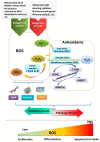Short Overview of ROS as Cell Function Regulators and Their Implications in Therapy Concepts
- PMID: 31366062
- PMCID: PMC6721558
- DOI: 10.3390/cells8080793
Short Overview of ROS as Cell Function Regulators and Their Implications in Therapy Concepts
Abstract
The importance of reactive oxygen species (ROS) has been gradually acknowledged over the last four decades. Initially perceived as unwanted products of detrimental oxidative stress, they have been upgraded since, and now ROS are also known to be essential for the regulation of physiological cellular functions through redox signaling. In the majority of cases, metabolic demands, along with other stimuli, are vital for ROS formation and their actions. In this review, we focus on the role of ROS in regulating cell functioning and communication among themselves. The relevance of ROS in therapy concepts is also addressed here.
Keywords: cancer; cellular processes; metabolism; physiology; reactive oxygen species (ROS); redox signaling; therapy.
Conflict of interest statement
The authors declare no conflict of interest.
Figures



Similar articles
-
Regulation of redox balance in cancer and T cells.J Biol Chem. 2018 May 18;293(20):7499-7507. doi: 10.1074/jbc.TM117.000257. Epub 2017 Dec 27. J Biol Chem. 2018. PMID: 29282291 Free PMC article. Review.
-
ROS: Basic Concepts, Sources, Cellular Signaling, and its Implications in Aging Pathways.Oxid Med Cell Longev. 2022 Oct 19;2022:1225578. doi: 10.1155/2022/1225578. eCollection 2022. Oxid Med Cell Longev. 2022. PMID: 36312897 Free PMC article. Review.
-
Redox signaling and cancer: the role of "labile" iron.Cancer Lett. 2008 Jul 18;266(1):21-9. doi: 10.1016/j.canlet.2008.02.038. Epub 2008 Apr 18. Cancer Lett. 2008. PMID: 18374479 Review.
-
Mitochondrial ROS and cancer drug resistance: Implications for therapy.Pharmacol Res. 2015 Oct;100:170-4. doi: 10.1016/j.phrs.2015.06.013. Epub 2015 Aug 11. Pharmacol Res. 2015. PMID: 26276086 Free PMC article. Review.
-
The multifaceted role of reactive oxygen species in tumorigenesis.Cell Mol Life Sci. 2020 Nov;77(22):4459-4483. doi: 10.1007/s00018-020-03536-5. Epub 2020 May 1. Cell Mol Life Sci. 2020. PMID: 32358622 Free PMC article. Review.
Cited by
-
Novel Strategies for Tumor Treatment: Harnessing ROS-Inducing Active Ingredients from Traditional Chinese Medicine Through Multifunctional Nanoformulations.Int J Nanomedicine. 2024 Sep 17;19:9659-9688. doi: 10.2147/IJN.S479212. eCollection 2024. Int J Nanomedicine. 2024. PMID: 39309188 Free PMC article. Review.
-
Peroxiporins and Oxidative Stress: Promising Targets to Tackle Inflammation and Cancer.Int J Mol Sci. 2024 Aug 1;25(15):8381. doi: 10.3390/ijms25158381. Int J Mol Sci. 2024. PMID: 39125952 Free PMC article. Review.
-
MYB transcription factors-master regulators of phenylpropanoid biosynthesis and diverse developmental and stress responses.Plant Cell Rep. 2022 Dec;41(12):2245-2260. doi: 10.1007/s00299-022-02927-1. Epub 2022 Sep 29. Plant Cell Rep. 2022. PMID: 36171500 Review.
-
The critical role of cardiolipin in metazoan differentiation, development, and maturation.Dev Dyn. 2023 Jun;252(6):691-712. doi: 10.1002/dvdy.567. Epub 2023 Feb 9. Dev Dyn. 2023. PMID: 36692477 Free PMC article. Review.
-
Construction of Selenium Nanoparticle-Loaded Mesoporous Silica Nanoparticles with Potential Antioxidant and Antitumor Activities as a Selenium Supplement.ACS Omega. 2022 Dec 1;7(49):44851-44860. doi: 10.1021/acsomega.2c04975. eCollection 2022 Dec 13. ACS Omega. 2022. PMID: 36530304 Free PMC article.
References
-
- Sies H. Oxidative stress: Introductory remarks. In: Sies H., editor. Oxidative Stress. Academic Press; London, UK: 1985. pp. 1–7.
-
- Sies H. On the history of oxidative stress: Concept and some aspects of current development. Curr. Opin. Toxicol. 2018;7:122–126. doi: 10.1016/j.cotox.2018.01.002. - DOI
-
- Egea J., Fabregat I., Frapart Y.M., Ghezzi P., Görlach A., Kietzmann T., Kubaichuk K., Knaus U.G., Lopez M.G., Olaso-Gonzalez G., et al. European contribution to the study of ROS: A summary of the findings and prospects for the future from the COST action BM1203 (EU-ROS) Redox Biol. 2017;13:94–162. doi: 10.1016/j.redox.2017.05.007. - DOI - PMC - PubMed
Publication types
MeSH terms
Substances
LinkOut - more resources
Full Text Sources

